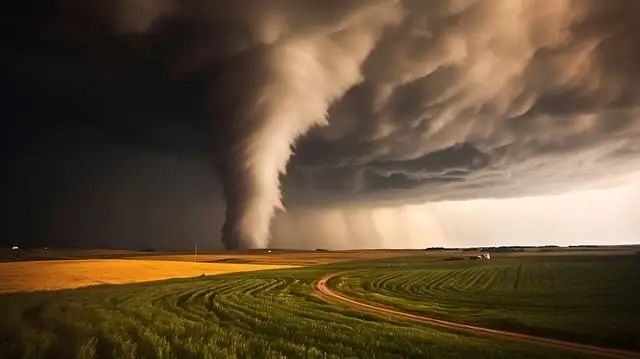Introduction
Tornadoes are among nature’s most powerful and destructive phenomena. These violent storms can cause significant damage, loss of life, and long-lasting impacts on communities. In the United States, which experiences more tornadoes than any other country, understanding these natural disasters and knowing how to prepare for them is crucial for safety and resilience. This blog post delves into the science behind tornadoes, their formation, the devastation they can cause, and essential precautions to take to mitigate their impact.
What is a Tornado?
A tornado is a rapidly rotating column of air that extends from a thunderstorm to the ground. Tornadoes are characterized by their funnel-shaped appearance and are often associated with severe weather conditions such as thunderstorms. The intensity of a tornado is measured using the Enhanced Fujita (EF) scale, which rates tornadoes from EF0 (weakest) to EF5 (strongest) based on the damage they cause.
How Tornadoes Form?
The formation of tornadoes is a complex process involving several atmospheric conditions. Here are the key factors that contribute to tornado development:
- Thunderstorms: Tornadoes typically form within powerful thunderstorms known as supercells. Supercells are characterized by a deep, persistently rotating updraft called a mesocyclone.
- Warm, Moist Air: The presence of warm, moist air at the surface is crucial for the development of thunderstorms. This air acts as fuel for the storm.
- Cold, Dry Air: Cold, dry air in the upper atmosphere can create instability, which is necessary for severe weather. The contrast between the warm, moist air at the surface and the cold, dry air aloft creates a condition called wind shear.
- Wind Shear: Wind shear refers to the change in wind speed and direction with height. This creates a rotating column of air within the storm, which can develop into a tornado if the conditions are right.
- Lift: A lifting mechanism, such as a front or a boundary, forces the warm, moist air upwards into the atmosphere, where it cools and condenses to form a thunderstorm.
The Life Cycle of a Tornado
Tornadoes typically go through a life cycle that includes the following stages:
- Formation: The rotating column of air, or mesocyclone, begins to tighten and stretch, eventually reaching the ground as a visible funnel.
- Mature Stage: The tornado reaches its maximum size and intensity, causing the most significant damage during this phase.
- Dissipation: The tornado weakens as the inflow of warm, moist air is cut off. The funnel becomes fragmented and eventually dissipates.
Tornadoes in the United States
The United States experiences more tornadoes than any other country, with an average of about 1,200 tornadoes per year. The majority of these occur in an area known as “Tornado Alley,” which includes parts of Texas, Oklahoma, Kansas, Nebraska, and South Dakota. Tornadoes are also common in the southeastern United States, an area sometimes referred to as “Dixie Alley.”
The Impact of Tornadoes
The impact of tornadoes can be devastating, both in terms of human lives and property damage. Here are some of the ways tornadoes can affect communities:
- Loss of Life and Injuries: Tornadoes can cause significant casualties, particularly if they strike populated areas. The high winds can pick up and hurl debris, which poses a severe risk to anyone in the storm’s path.
- Property Damage: The powerful winds of a tornado can destroy homes, businesses, and infrastructure. Tornadoes can flatten entire neighborhoods, leaving behind a trail of destruction.
- Economic Impact: The cost of rebuilding after a tornado can be substantial. Communities may face economic challenges as they work to repair damage and restore services.
- Emotional and Psychological Effects: Surviving a tornado and dealing with the aftermath can be a traumatic experience. Many people experience stress, anxiety, and grief in the wake of such a disaster.
Precautions and Preparedness
Given the destructive potential of tornadoes, it is crucial to take precautions and be prepared. Here are essential steps to protect yourself and your loved ones:
Before a Tornado
- Know the Risk: Understand the tornado risk in your area. Familiarize yourself with the local weather patterns and historical tornado activity.
- Create an Emergency Plan: Develop a family emergency plan that includes a designated safe area, such as a basement or storm shelter. Ensure all family members know where to go and what to do during a tornado.
- Emergency Kit: Prepare an emergency kit with essential supplies, including water, non-perishable food, medications, flashlights, batteries, a first aid kit, and important documents.
- Stay Informed: Monitor weather forecasts and alerts from reliable sources such as the National Weather Service (NWS). Sign up for emergency notifications if available in your area.
- Secure Your Home: Take steps to secure your home against high winds. Reinforce doors and windows, and consider installing storm shutters. Ensure that outdoor furniture and other items are secured or brought indoors.
During a Tornado
- Seek Shelter Immediately: When a tornado warning is issued or you see signs of a tornado, such as a dark, greenish sky or a loud roar, seek shelter immediately. The safest place is a basement or a small, windowless interior room on the lowest floor of a sturdy building.
- Cover Yourself: Protect yourself from flying debris by covering your head and neck with your arms. If possible, use a heavy blanket, mattress, or helmet for additional protection.
- Avoid Windows: Stay away from windows, doors, and outside walls. Flying glass and debris can cause serious injuries.
- Mobile Homes and Vehicles: Do not stay in a mobile home or vehicle during a tornado. If you are caught in a vehicle, seek shelter in a nearby building. If there is no shelter available, lie flat in a low-lying area and cover your head with your hands.
After a Tornado
- Wait for All Clear: Stay in your shelter until you are certain the tornado has passed and it is safe to come out. Listen to weather reports and emergency announcements.
- Check for Injuries: Once it is safe, check yourself and others for injuries. Provide first aid and seek medical attention if necessary.
- Avoid Hazards: Be aware of hazards such as downed power lines, broken glass, and unstable structures. Do not enter damaged buildings until they have been inspected and deemed safe.
- Communicate with Loved Ones: Contact family and friends to let them know you are safe. Use text messages or social media to keep phone lines clear for emergency calls.
- Document Damage: Take photos and document any damage to your property for insurance purposes. Contact your insurance company to start the claims process.
Community Preparedness and Resilience
Individual preparedness is crucial, but community-wide efforts can significantly enhance resilience to tornadoes. Here are some ways communities can prepare and respond to tornadoes:
- Emergency Response Plans: Local governments and organizations should have comprehensive emergency response plans that include tornado preparedness and response. Regular drills and exercises can ensure that everyone knows their role during a disaster.
- Public Education and Awareness: Community education programs can raise awareness about tornado risks and promote preparedness. Schools, workplaces, and community centers can host informational sessions and distribute materials on tornado safety.
- Warning Systems: Effective warning systems, such as sirens and emergency alerts, are essential for providing timely warnings to residents. Communities should regularly test these systems and ensure they are in working order.
- Building Codes and Regulations: Implementing and enforcing building codes that require structures to withstand high winds can reduce property damage and save lives. Communities in tornado-prone areas should consider adopting wind-resistant building standards.
- Shelters and Safe Rooms: Public storm shelters and safe rooms can provide protection for residents who do not have access to a safe area in their homes. Communities should ensure that these shelters are well-maintained and accessible.
- Mutual Aid Agreements: Establishing mutual aid agreements with neighboring communities can facilitate the sharing of resources and support during a disaster. This can include emergency personnel, equipment, and supplies.
Advances in Tornado Prediction and Research
Advancements in meteorology and technology have improved our ability to predict and understand tornadoes. Here are some key developments:
- Improved Radar Technology: Doppler radar and dual-polarization radar have enhanced our ability to detect tornadoes and their precursors. These technologies provide detailed information about storm structure and rotation.
- Storm Chasing and Research: Storm chasers and researchers collect valuable data on tornadoes by getting close to storms. This data helps improve our understanding of tornado formation and behavior.
- Computer Models and Simulations: Advanced computer models and simulations allow scientists to study tornado dynamics and predict storm behavior more accurately. These models help meteorologists issue more precise warnings.
- Enhanced Warning Systems: The development of more sophisticated warning systems, including mobile apps and social media alerts, ensures that people receive timely and accurate information about tornado threats.
- Public Awareness Campaigns: Ongoing public awareness campaigns educate people about tornado risks and preparedness. These campaigns emphasize the importance of taking warnings seriously and knowing what to do in a tornado.
The Role of Climate Change
While the relationship between climate change and tornadoes is still being studied, there is evidence to suggest that a changing climate may influence tornado activity. Here are some potential impacts:
- Increased Storm Intensity: Climate change may lead to more intense thunderstorms, which could result in stronger and more frequent tornadoes.
- Shifts in Tornado Alley: Some research suggests that Tornado Alley may shift geographically as climate patterns change. This could mean more tornadoes in areas that are not traditionally tornado-prone.
- Changes in Seasonality: The timing of tornado outbreaks may shift, with an increase in tornadoes during times of the year that are not typically peak tornado season.
Conclusion
Tornadoes are powerful and unpredictable forces of nature that can have devastating impacts on communities. Understanding how tornadoes form, recognizing the signs of an impending tornado, and knowing what precautions to take can significantly reduce the risks associated with these storms. Preparedness is key to ensuring the safety and resilience of individuals and communities in the face of tornado threats.
By staying informed, creating emergency plans, and supporting community-wide preparedness efforts, we can mitigate the impact of tornadoes and build a more resilient society. Advances in meteorology and technology continue to improve our ability to predict and respond to tornadoes, offering hope for reducing their destructive potential in the future. As we adapt to a changing climate, it is essential to remain vigilant and proactive in our efforts to protect lives and property from the dangers of tornadoes.








sit beatae officia quam corrupti sed at quo omnis quibusdam fuga. porro neque laboriosam et quaerat culpa placeat exercitationem.
harum distinctio officiis dolorum explicabo accusamus consequatur totam autem libero cum alias laborum eos qui nulla quas omnis non. dolor in illo iure labore consequatur dolorem repellendus eos veniam est distinctio sit dolor explicabo consequatur est dolor et.
et voluptatibus qui cum earum. dicta molestiae pariatur amet qui mollitia corrupti hic officia quia sapiente corporis corporis accusantium vel repudiandae autem autem sit. repudiandae illo laborum debitis quidem facere maxime et provident possimus quia. ipsa occaecati sit laborum.